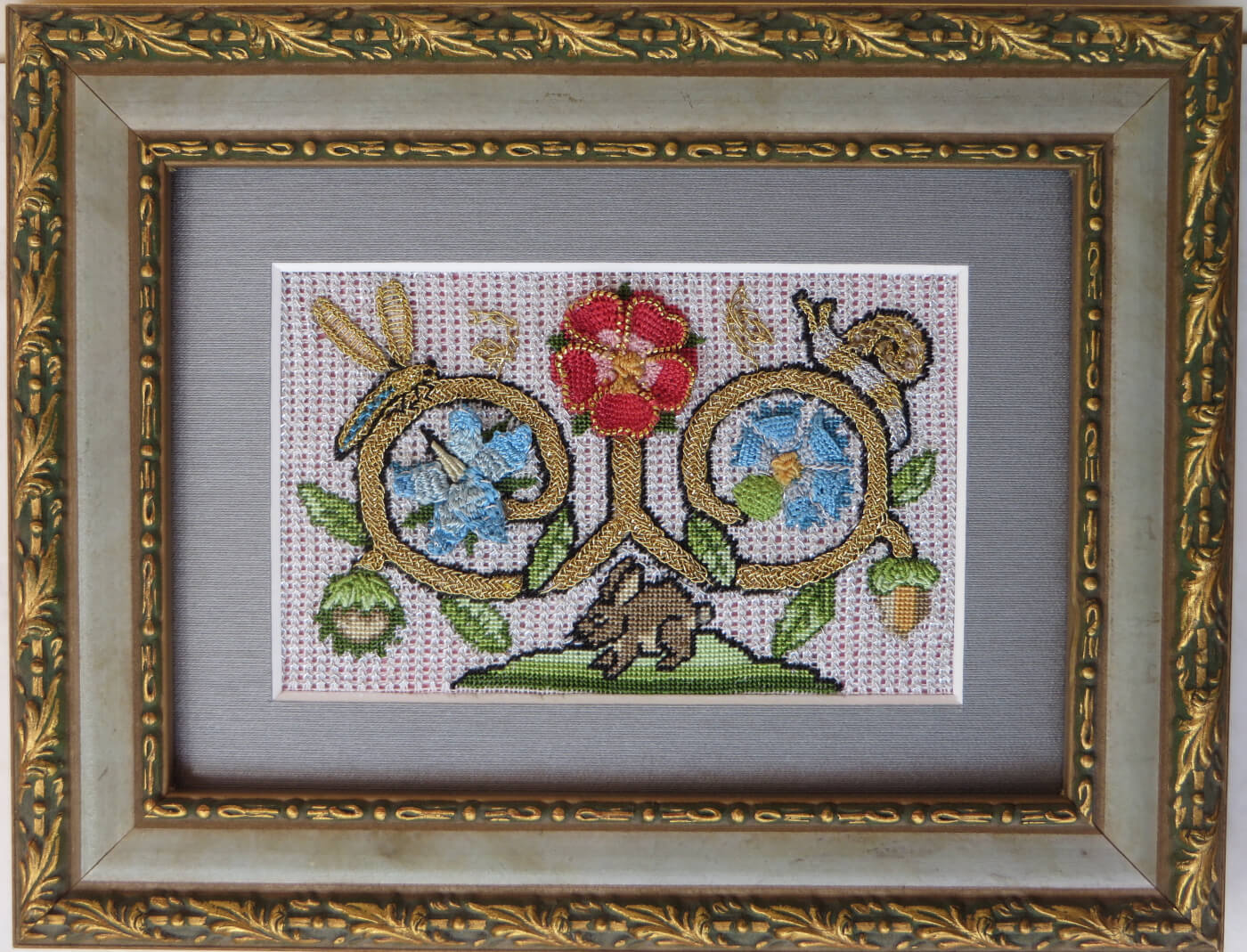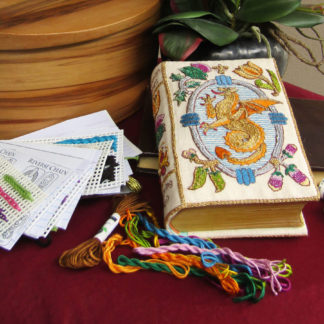Sweet Bag Sewed of Silver and Gold
Learn about historical sweet bags and then create your own!
In our Group Correspondence Course Sweet Bag Sewed of Silver and Gold stitch an embroidered bag like the ones that were in style in England from the mid-1500s to the mid-1600s. Then fashion and styles changed, and they stopped being made. Over two hundred have survived to the present. This course describes how to make a bag similar to surviving ones.
The instruction book starts with an overview of historical sweet bags. It tells why they were called sweet, how they were constructed, and what materials were used. Then it discusses typical design layouts, historical uses, and accessories, with pointers to further information for those interested. It then provides a pattern for this bag, which is in the tradition of historical bags, with nods to the New World. The next section notes general stitching information, including a page on taming the metal passing thread. There is guidance on choosing ground fabric, floss, metal threads, and beads before the lessons.
Two-thirds of this course is about stitching, one-third is about construction.
Intermediate and Advanced stitchers should be comfortable with this course. Stitchers should be willing to make decisions based on presented alternatives. Decisions are about materials, color placement, shading styles, and pattern customization.
The course is also aimed at history buffs interested in textiles. Besides the brief overview mentioned above, each stitch description also lists surviving artifacts that use it and where to find photos. Those interested can then compare their efforts with those of embroiderers 400 years ago.
The finishing examples may be worked on a separate, non-embroidered bag.
A Certificate of Completion requires stitched examples of all stitches and techniques. The latter may be either a completed bag or one fully stitched side and a completed practice bag.
More about Sweet Bag Sewed of Silver and Gold
-
Class Details
Type of project: Embroidered drawstring bag
Size of project: 5″ x 9.5″ stitching area, folded to form a bag 5″ wide x 4.75″ tall
Color choices, if offered: one colorway is provided, but Students are free to make their own choices.
Supplies used: Linen ground fabric, silk threads, metal passing threads, small amount of gilt and silver specialty threads; construction materials include large decorative beads, drawstring cords (such as shoelaces), perle cotton, taffeta lining fabric
Skill level: Intermediate or Advanced
Prerequisites, if any: Interest in 16th c. embroidery; ability to read a stitch diagram; willingness to tackle bag finishing.
Timeline for course: Six Lessons; the first three lessons may take more than a month each, so I suggest nine months.
Fee per group: $200
Text price: $55.00 for full color-bound book, 72pp.
Estimated supply cost: About $65 for cotton floss and sharing the rest; about $120 for silk and sharing the rest. If one is not sharing costs, then the total is about $125/person for cotton and $180/person for silk. -
Lessons
• Lesson 1 covers Tent stitch, shading styles, and transitioning between shades.
• Lesson 2 explains Plaited Braid, perhaps the most iconic stitch of the era.
• Lesson 3 works the two common background stitches, Elizabethan Ground and Plaited Gobelin.
• Lesson 4 explains some specialty stitches using purl threads and spangles.
• Lesson 5 shows how to make wrapped cords and tassels. It has a bonus section on making decorative Turk’s Head knots, but one can use large beads instead.
• Lesson 6 pulls it all together to make a finished drawstring bag. -
About teacher Melinda Sherbring
Melinda was a software engineer in Southern California’s aerospace industry from 1975-2013. Through her historical re-enactment hobby, she researched and published booklets on Pictish art, heraldry, and manuscripts. She found EGA in 1992, expanding her horizons to historical embroidery and studying surviving works at museums worldwide. Her first EGA Group Correspondence Course, More Than a Rose, appeared in 2016. Melinda now teaches, writes, and publishes as Threads of History.
Needle Arts Profile: Designer and Teacher Melinda Sherbring
-
More about our Group Correspondence Courses and GCC Lightning Rounds
Visit our Group Correspondence Courses page for the registration form and for more information on how our GCCs work.
Our GCC Lightning Rounds are three or four of our Group Correspondence Courses that have been hand-picked by our Education Department and made available for individual EGA members to register without a group for a limited time. Visit our GCC Lightning Rounds page to see which courses are available this quarter!
There are no refunds for course or text fees so make your selection carefully.


